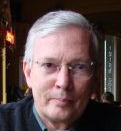by Tom Reeves
The first time
Usually I do not pay much attention when someone stops me on the street to ask for directions: I offer what information I can muster and then I continue on my way. But on this particular day, as I was making my way up Avenue des Gobelins toward Place d’Italie, someone approached me from behind and tapped me on the left forearm. I turned to look, and a young man asked me where the metro was located. I replied that it was back in the direction from which we were walking. He turned to walk in that direction and at that moment I was aware that another young man had been on my right during the encounter. I realized that the second man had probably tried to unzip the bag that I carry, bandolier-style, over my right hip. I thought that he probably failed, and, when I inspected the bag, I was right.
I put the incident out of my mind.
The second time
The second time occurred a day or two later as I was making my way up Passage des Postes, a walkway that links two parallel streets. Just as I reached the end of the passageway, a man approached me from behind on my left and asked me where the metro was. I turned to him and replied that it was in the direction from which he came. He thanked me and turned to walk in that direction. This time, there was no one with him, so I imagined that his inquiry was sincere, although I began wondering if there was some new phenomenon occurring that was inciting people to begin asking for directions so frequently.
The third time
The third time occurred just one or two days later when my wife and I were making our way up a narrow stairway that leads from one platform to another in the Ecole Militaire metro station. This time a young man tapped me on the left forearm and asked me if I could tell him the time. I thought that it should have been obvious to him that I was not wearing a watch, and replied that I did not know. When my wife and I arrived at the upper platform, I realized that another young man, who was associated with the one who asked the question, had been behind us and to our right. For some reason I did not attribute any malicious intent to this encounter.
The fourth time
The fourth time occurred the same day as we were making our way up Passage des Postes. Just as we got to the end of the walkway, a young man, approaching from behind, tapped me on the left forearm and asked me where the metro was located. I turned to him and indicated that it was in the direction from which he was walking. Then he asked again, and my wife repeated what I had said. At that point I saw that there was a second young man who had been following us on our right. We watched them walk away.
Just five minutes later, arriving in our apartment, my wife realized that her wallet was missing from her small, zipped purse, which she was carrying over her shoulder along with a second, larger bag. We concluded that it must have been the man on the right who stole the wallet while we were distracted by the first man in the Passage des Postes.
My wife quickly called all her credit card companies to alert them to the theft.
About an hour later, a woman who lives in the Passage des Postes contacted my wife to tell her that she found the wallet in front of her door. My wife rushed to retrieve it and found that the small amount of cash in the wallet had been stolen as well as two local credit cards.
The conclusions that I draw from this
I think that a group of thieves has swept into Paris and will pull this stunt for as long as they can get away with it. And then they will move on to another town.
Whether I am right or not, I write this to alert people about what is happening on the streets of Paris. It is not sufficient to carry a zipped purse or zipped bag to prevent pick pocketing. The bag that I carry also has a clasp, which, until now, I never used, because it requires so much fumbling to secure it to the pull of the zipper. But that is now the point: if is difficult for me to secure, then it will be difficult for a pickpocket to open quickly while his partner tries to engage me in brief conversation.
Be aware and alert!






















